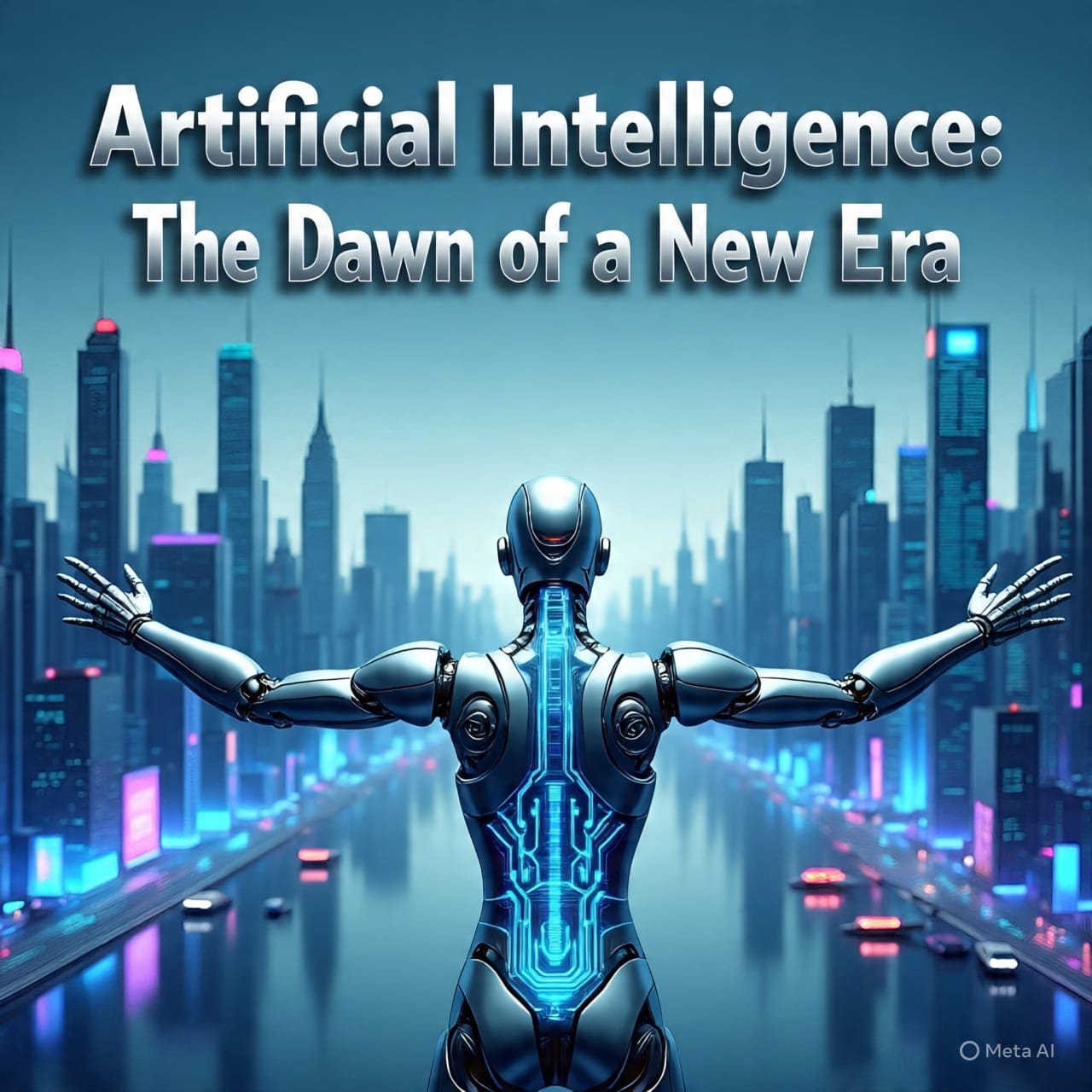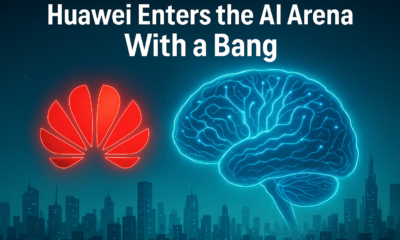AI Insights
Artificial Intelligence: The Dawn of a New Era

Artificial Intelligence (AI) is no longer a distant concept confined to science fiction novels or futuristic movies; it has become an integral part of our lives. From voice assistants like Siri and Alexa to self-driving cars and medical diagnostic tools, AI is shaping the world in profound ways. As we stand on the cusp of a technological revolution, it’s essential to understand both the potential of AI and the challenges it presents—especially regarding its ethical, societal, and economic implications.
The Rise of AI: A Technological Revolution
The term “Artificial Intelligence” was first coined in 1956 by John McCarthy, but it wasn’t until recent decades that AI truly began to flourish. The exponential growth in computational power, the availability of vast amounts of data, and advancements in machine learning algorithms have allowed AI to evolve at an unprecedented rate. Today, AI is powering systems that can recognize speech, understand images, predict behavior, and even outperform humans in certain tasks.
Machine learning, a subset of AI, has particularly advanced in recent years. Algorithms now allow computers to learn from data without being explicitly programmed. Whether it’s recommending products on Amazon, detecting fraudulent transactions, or analyzing medical scans, AI’s ability to process vast amounts of data and uncover patterns is unmatched by human capabilities.
The Transformative Potential of AI
The potential applications of AI are vast and far-reaching. In healthcare, AI is revolutionizing diagnostics and treatment plans. Machine learning models can analyze medical data with extraordinary precision, sometimes identifying conditions that would take human doctors much longer to detect. AI-powered tools, such as IBM Watson Health, can help doctors interpret complex datasets, assist in personalized medicine, and even predict patient outcomes based on historical data.
In business, AI is streamlining operations, improving customer service, and enhancing decision-making. For instance, chatbots powered by AI can handle customer inquiries 24/7, reducing the burden on human agents and improving response times. In marketing, AI is enabling companies to tailor advertisements based on consumer behavior, enhancing targeting accuracy and ultimately driving sales.
The automotive industry is also benefiting from AI, with self-driving cars becoming more of a reality. Companies like Tesla, Waymo, and others are investing heavily in autonomous driving technology, promising to reduce road accidents and transform the way we commute. AI’s ability to interpret data from sensors and cameras allows autonomous vehicles to navigate complex environments, avoid collisions, and optimize driving behavior.
AI is even making strides in the arts. Machine-generated music, paintings, and poetry are no longer novelties but respected art forms in their own right. AI algorithms, like OpenAI’s GPT models, are pushing the boundaries of creativity, collaborating with human artists to create novel works of art.
Challenges: The Dark Side of AI
Despite its remarkable potential, AI comes with its own set of challenges and risks. One of the most significant concerns is the displacement of jobs. As AI continues to automate tasks traditionally performed by humans, millions of jobs—especially those in sectors like retail, manufacturing, and transportation—are at risk. In fact, a 2017 report by McKinsey predicted that up to 800 million workers worldwide could be replaced by robots and AI by 2030.
This has profound implications for the global economy. While AI could lead to the creation of new industries and job categories, the transition could be rocky. Workers displaced by automation will need retraining, and societies will need to develop strategies for ensuring that the benefits of AI are distributed equitably. Otherwise, the gap between the wealthy and the impoverished could widen, exacerbating existing social inequalities.
Another challenge posed by AI is its potential to amplify biases. AI systems are only as good as the data they are trained on. If the data reflects societal biases—whether racial, gender-based, or socioeconomic—AI models can inadvertently perpetuate and even exacerbate these biases. For example, facial recognition software has been shown to have higher error rates when identifying people of color, leading to concerns about discrimination, especially in law enforcement.
AI’s decision-making processes can also be opaque. Many advanced AI models, especially deep learning algorithms, are considered “black boxes” because it’s often difficult to understand how they arrive at a particular conclusion. This lack of transparency raises concerns in critical areas like healthcare, criminal justice, and finance, where understanding the rationale behind an AI’s decision is essential.
Ethical Considerations: The Moral Dilemmas of AI
As AI technology becomes more powerful, its ethical implications become more pressing. One of the most significant questions is about the control and accountability of AI systems. Who is responsible when an AI system makes a mistake? For instance, if a self-driving car causes an accident, is the responsibility on the manufacturer, the programmer, or the car itself?
AI’s potential to surpass human intelligence also raises existential questions. Could AI ever become too powerful for us to control? Some experts, like Elon Musk and Stephen Hawking, have warned that AI, if left unchecked, could become an existential threat to humanity. While this may sound like science fiction, the possibility of creating superintelligent machines that could make decisions independent of human oversight is a very real concern.
Moreover, the ethics of AI in warfare are deeply troubling. Autonomous drones and robots equipped with AI could change the nature of warfare, making it more efficient but also more lethal. The idea of machines making life-and-death decisions without human input raises moral concerns, particularly in the context of international conflicts.
The Future of AI: A Double-Edged Sword
As we move forward, the future of AI will depend on how we balance its benefits and risks. To fully realize the potential of AI, we need to address its challenges head-on, with a focus on ethics, regulation, and inclusivity. Governments, researchers, and technologists must work together to ensure that AI is developed responsibly and that its benefits are shared by all of humanity.
The role of ethics in AI cannot be overstated. Ethical frameworks and guidelines will be crucial in ensuring that AI serves humanity’s best interests. Furthermore, societies will need to invest in education and workforce development to ensure that individuals have the skills to thrive in an AI-driven world.
Ultimately, the future of AI is not predetermined. It is in our hands to shape it. If approached wisely, AI could be the most transformative technology humanity has ever known, unlocking new frontiers in science, medicine, and human potential. However, if we fail to address its challenges and ethical implications, AI could also become one of the most disruptive forces we’ve ever faced.
Conclusion: Embracing AI with Caution
Artificial Intelligence is a powerful tool that promises to revolutionize every aspect of our lives. While its potential is vast, the challenges it presents—particularly in terms of employment, bias, accountability, and ethics—demand careful consideration and thoughtful action. As we continue to advance in the age of AI, it is crucial that we maintain a balance between innovation and responsibility, ensuring that AI serves humanity’s greater good rather than creating new problems.
The dawn of AI has arrived, and with it comes both unprecedented opportunities and complex challenges. How we choose to navigate this new era will determine whether AI becomes a force for good or a source of unintended consequences.
AI Insights
Can artificial intelligence start a nuclear war?

Stanford University simulations have shown that current artificial intelligence models are prone to escalating conflicts to the point of nuclear weapons. The study raises serious questions about the risks of automating military decisions and the role of AI in future wars.
This is reported by Politico .
The results of war games conducted by researcher Jacqueline Schneider from Stanford indicate that artificial intelligence could become a dangerous factor in modern wars if it gains influence over military decision-making.
According to the scientist, during simulations, the latest AI models consistently chose aggressive escalation scenarios, including the use of nuclear weapons. Schneider compared the behavior of the algorithms to the approach of Cold War general Curtis LeMay, who was known for his willingness to use nuclear force on minimal pretext.
“Artificial intelligence models understand perfectly well how to escalate a conflict, but are actually unable to offer options for its de-escalation,” the researcher explained.
In her opinion, this is due to the fact that most of the military literature used to train AI describes escalation scenarios, not those that avoided war.
The Pentagon assures that AI will not have the right to make decisions about launching nuclear missiles, and emphasizes the preservation of “human control.” At the same time, modern warfare is increasingly dependent on automated systems. Already today, projects like Project Maven rely entirely on machine-generated intelligence data, and in the future, algorithms will even be able to advise on countermeasures.
In addition, there are already examples of automation in the field of nuclear weapons in the world. Russia has the Perimeter system, capable of delivering a strike without human intervention, and China is investing huge resources in the development of military artificial intelligence.
Journalists also recall the case of 1979, when US President Jimmy Carter’s advisor Zbigniew Brzezinski received a message about the alleged launch of 200 Soviet missiles. Only a moment before the decision to retaliate was made, it turned out that this was a system error. The question is whether artificial intelligence, which works “reflexively”, would have been able to wait for more detailed information, or would have pressed the “red button” automatically.
Thus, the discussion about the role of AI in the military sphere is becoming increasingly relevant, because not only the outcome of the battle, but also the fate of all humanity may be at stake.
It was previously reported that the Thwaites Glacier in Antarctica, nicknamed the “Doomsday Glacier,” is losing stability and could trigger a rapid rise in sea levels by several meters.
Recall that Hollywood actor and musician Will Smith was involved in a scandal. In particular, the star of “Men in Black” was suspected of using artificial intelligence.
Also follow “Pryamim” on Facebook , Twitter , Telegram , and Instagram.
AI Insights
Varo Bank Appoints Asmau Ahmed as Chief Artificial Intelligence Officer to Drive AI Innovation

Varo Bank has hired Asmau Ahmed as its first Chief Artificial Intelligence and Data Officer (CAIDO) to lead company-wide AI and machine-learning efforts. Ahmed has over 20 years of experience in leading teams and delivering products at Google X, Bank of America, Capital One, and Deloitte. She will focus on advancing Varo’s mission-driven tech evolution and improving customers’ financial experiences through AI. Varo uses AI to enhance its credit-decisioning processes, and Ahmed’s expertise will help guide future institution-wide advancements in AI.
Title: Varo Bank Appoints Asmau Ahmed as Chief Artificial Intelligence and Data Officer
Varo Bank, the first all-digital nationally chartered bank in the U.S., has announced the hiring of Asmau Ahmed as its first Chief Artificial Intelligence and Data Officer (CAIDO). Ahmed, who brings over 20 years of expertise in innovation from Google, Bank of America, and Capital One, will lead the company’s AI and machine-learning efforts, reporting directly to CEO Gavin Michael [1].
Ahmed’s appointment comes as Varo Bank continues to leverage AI to enhance its core functions. The bank has expanded credit access by using data and advanced machine learning-driven decisioning, reinforcing its mission of advancing financial inclusion with technology. The Varo Line of Credit, launched in 2024, uses self-learning models to improve its credit-decisioning processes based on proprietary algorithms, allowing some customers with reliable Varo banking histories access to loans that traditional credit score systems would have excluded [1].
Ahmed’s extensive experience includes leading technology, portfolio, and customer-facing product teams at Bank of America and Capital One, as well as co-leading the Digital Innovation team at Deloitte. She has also founded a visual search advertising tech company, Plum Perfect. Her expertise will be instrumental in guiding Varo Bank’s future advancements in AI.
“As a nationally-chartered bank, Varo is able to use data and AI in an innovative way that stands out across the finance industry,” said Ahmed. “Today we are applying machine learning for underwriting, as well as fraud prevention and detection. I am thrilled to lead the next phase of Varo’s mission-driven tech evolution and ensure AI can improve our customers’ experiences and financial lives” [1].
Varo Bank’s AI and data science efforts are designed to enhance various core functions of the company’s tech stack. The appointment of Ahmed as CAIDO underscores the bank’s commitment to leveraging AI to improve customer experiences and financial outcomes.
References
[1] https://www.businesswire.com/news/home/20250904262245/en/Varo-Bank-to-Accelerate-Responsible-and-Customer-Focused-AI-Efforts-with-New-Chief-Artificial-Intelligence-Officer-Asmau-Ahmed
AI Insights
Guest column—University of Tennessee “Embraces” Artificial Intelligence, Downplays Dangers – The Pacer
At the end of February, the University of Tennessee Board of Trustees adopted its first artificial intelligence policy.
The board produced its policy statement with little attempt to engage faculty and students in meaningful discussions about the serious problems that may arise from AI.
At UT Martin, the Faculty Senate approved the board’s policy statement in late April, also without significant input from faculty or students.
In Section V of the document, “Policy Statement and Guiding Principles,” the first subsection states: “UT Martin embraces the use of AI as a powerful tool for the purpose of enhancing human learning, creativity, analysis, and innovation within the academic context.”
The document notes potential problems such as academic integrity, the compromise of intellectual property rights and the security of protected university data. But it does not address what may be the most dangerous and most likely consequence of AI’s rapid growth: the limiting of human learning, creativity, analysis and innovation.
Over the past two years, faculty in the humanities have seen students increasingly turn to AI, even for low-stakes assignments. AI allows students to bypass the effort of trying to understand a reading.
If students attempt a difficult text and struggle to make sense of it, they can ask AI to explain. More often, however, students skip reading altogether and ask AI for a summary, analysis or other grade-directed answers.
In approaching a novel, a historical narrative or even the social realities of our own time, readers start with limited knowledge of the characters, events or forces at play. To understand a character’s motives, the relationship between events, or the social, economic and political interests driving them, we must construct and refine a mental image—a hypothesis—through careful reading.
This process is the heart of education. Only by grappling with a text, a formula or a method for solving a problem do we truly learn. Without that effort, students may arrive at the “right” answer, but they have not gained the tools to understand the problems they face—or to live morally and intelligently in the world.
As complex as a novel or historical narrative may be, the real world is far more complex. If we rely on AI’s interpretation instead of building our own understanding, we deprive ourselves of the skills needed to engage with that complexity.
UT Martin’s mission statement says: “The University of Tennessee at Martin educates and engages responsible citizens to lead and serve in a diverse world.” Yet we fail this mission in many ways. Most students do not follow current events and are unaware of pressing issues. Few leave the university with a love of reading, despite its importance to responsible citizenship.
With this new AI policy, the university risks compounding these failures by embracing a technology that may further erode students’ ability to think critically about the world around them.
-

 Business6 days ago
Business6 days agoThe Guardian view on Trump and the Fed: independence is no substitute for accountability | Editorial
-
Tools & Platforms3 weeks ago
Building Trust in Military AI Starts with Opening the Black Box – War on the Rocks
-

 Ethics & Policy1 month ago
Ethics & Policy1 month agoSDAIA Supports Saudi Arabia’s Leadership in Shaping Global AI Ethics, Policy, and Research – وكالة الأنباء السعودية
-

 Events & Conferences4 months ago
Events & Conferences4 months agoJourney to 1000 models: Scaling Instagram’s recommendation system
-

 Jobs & Careers2 months ago
Jobs & Careers2 months agoMumbai-based Perplexity Alternative Has 60k+ Users Without Funding
-

 Education2 months ago
Education2 months agoVEX Robotics launches AI-powered classroom robotics system
-

 Funding & Business2 months ago
Funding & Business2 months agoKayak and Expedia race to build AI travel agents that turn social posts into itineraries
-

 Podcasts & Talks2 months ago
Podcasts & Talks2 months agoHappy 4th of July! 🎆 Made with Veo 3 in Gemini
-

 Podcasts & Talks2 months ago
Podcasts & Talks2 months agoOpenAI 🤝 @teamganassi
-

 Education2 months ago
Education2 months agoMacron says UK and France have duty to tackle illegal migration ‘with humanity, solidarity and firmness’ – UK politics live | Politics



















